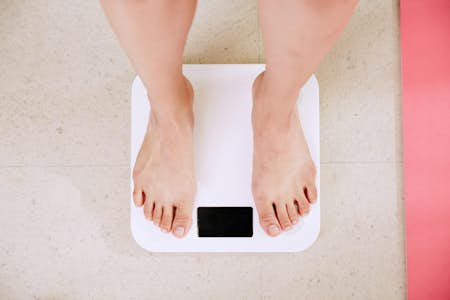We know it’s detrimental to our health and wellbeing, yet many of us spend a whopping 9 and a half hours a day sitting. To put it frankly, prolonged periods of sitting increase your risk of having a heart attack or stroke, developing type 2 diabetes, and losing strength in your muscles and bones.
I would sympathise with you for thinking that there’s little you can do about that; you have to work and pay your bills, which for most of us requires sitting at your desk 5-days-a-week. However, there are things you can do to break up your day and sit less.
Ready to transform your life? Whether you're looking for a new pair of running shoes or some shiny home gym equipment, you can find everything you need to fuel your fitness journey with our partner brands.
The damaging effects on older adults are often coupled with weight gain and chronic diseases. Research shows even when adults meet the weekly recommended amount of exercise (150 minutes a week of moderate intensity exercise, such as brisk walking or riding a bike), living a mostly sedentary lifestyle still results in a decline in metabolic functions responsible for burning sugars, fats and regulating blood pressure. This leads to an increased risk of older adults developing chronic diseases like obesity and cancer.
Try To Move More And Sit Less
Most of us live a sedentary lifestyle that is intertwined in the society we live and work in. We sit all day at work on the computer, drive home in the car, and plonk ourselves in front of the TV after work. Scientists assert there are two issues that need some intervention--how much time you spend sitting throughout the day, and how you break up sitting.
You can break up the time you spend sitting by getting up and moving around for 5 minutes every half hour or so. Many of us are currently working from home, so you could break off from your work and go for a walk; do some chores around the house, or even do a mini-workout. Keep your body moving to raise your metabolic rate; a faster metabolic rate can cut your risk of developing chronic illnesses.
Should You Get A Standing Desk?
You may have seen people working at standing desks in your office, perhaps even chuckling to yourself as you watch your colleagues standing up to do their work, or bust out a set of squats at their desk. While research into the benefits of using a standing desk is inconclusive, the Journal of Physical Activity and Health found that using a standing desk for 3 hours burns an extra 24 calories. Proponents of standing desks also say your blood sugar levels return to normal faster than if you were sitting, and standing may reduce the risk of posture problems and back pain.
If you decide to get a standing desk, it’s important not to go from sitting all day, to standing at your desk for most of the day. It’s better to ease yourself into it.
Harvard Health Publishing reports “if you suddenly go from sitting all day to standing all day, you run the risk of developing back, leg, or foot pain; it’s better to ease into it by starting with 30 to 60 minutes a day and gradually increasing it.”
So, it’s worth noting there still isn’t sufficient research into the benefits of standing desks, but logic tells us it might be an added extra which could provide some health benefits and be part of adding more activity into your day.
Be More Active Throughout The Day
The UK government advises “to reduce our risk of ill health from inactivity, we are advised to exercise regularly, at least 150 minutes a week, and reduce sitting time.”
But what does that mean in practice? The 150 minutes a week of exercise refers to moderate intensity exercise and includes:
- Brisk walking.
- Cycling.
- Doubles tennis.
- Pushing a lawnmower.
- Hiking.
- Rollerblading.
- Water aerobics.
In other words, you’ve got to try and move as much as possible. If you’ve been a couch potato for too long and rarely do any of the above, perhaps it’s time to think about changes you can make to your lifestyle.
Alternatively, an adult aged between 19-64 can do 75 minutes of vigorous intensity activity, such as:
- Going for a run.
- Playing a sport like football, rugby or hockey.
- Aerobics.
- Skipping.
- Martial arts.
- Swimming.
- Riding a bike fast or up hills.
You might be hoping that if you cheat and do the 75 minutes of vigorous activity over a couple of days or so, such as two workouts at the gym or cycling to work twice a week means you can sit down for the rest of the week. Sadly, this isn’t the case, and you should aim to be active at least 5 days per week to get the maximum health benefits. It’s the prolonged periods of sitting in your day which damage your health, and you need to try and break up your sitting time.
Lee-ann Cordingley of All You Yoga told us: "Waste, including broken-down stress hormones and normal disused cellular material, is recycled or removed from the body via the lymphatic drainage system which does not have a pump, unlike the veinous system with the heart. It relies heavily on muscular movement to effectively massage it on its path through the body.
"This is why you feel so good after exercising; any activity which involves you moving your muscles is quite literally steering you towards internal cleanliness and improved health, while sedentary periods can have you feeling lethargic and sluggish. So I'd hugely advocate finding a way of moving that you really enjoy."
Laura Green from Laura Green Yoga added: "So many age related medical conditions have an increased risk factor with more sedentary lifestyles. I truly believe that movement really is medicine for the body. Even simple yoga poses and standing stretches can help break up a prolonged day seated."
Other Tips To Reduce Sitting
You can reduce your sitting time by:
- Standing up on the bus or train.
- Taking the stairs instead of the lift or escalator.
- Walking around when on the phone.
- Walking around the office every time you take a coffee or tea break.
- Doing gardening and DIY instead of watching TV.
Break Up With Sitting And Be More Active
Hopefully, now you’re more aware of how 21st century working culture can adversely impact your health. If you don’t buy into the whole standing desk idea, or can’t see yourself bouncing around your office or home at the beck and call of your 30-minute reminder, look at ways you can make changes to your everyday lifestyle and prolong your life.
If you’re experiencing pain or exhibiting other symptoms during or after exercise, you should stop what you’re doing and seek medical attention.
With Scan.com, you can take action quickly and put your mind at ease.
Choose from 10 scan types at over 250 clinics nationwide and get the answers you need so you can continue looking after your health.
Visit Scan.com now to learn how it works and book your scan.









